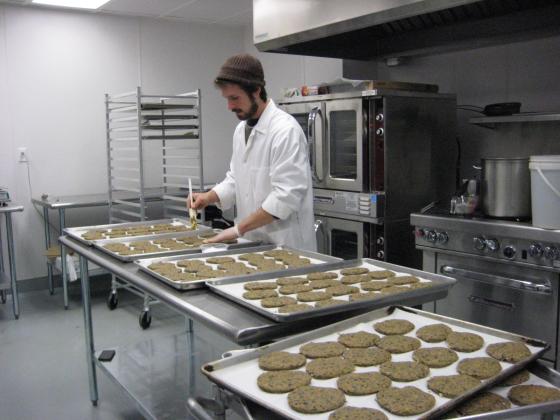Posted March 17, 2022 at 10:36am by Anonymous (not verified)
Mad River Food Hub

White walls and stainless steel sinks and industrial-sized freezers and workers in smocks may not form our image of “local food.” But if Vermont agriculture and food production are to remain viable, places like the Mad River Food Hub might become increasingly necessary.
Opened in October 2011, the Mad River Food Hub offers four basic services not easily accessible to Vermont farmers and food entrepreneurs: processing space, storage space, distribution assistance, and business planning. At the 4,000 square-foot facility in Waitsfield, vegetables can be turned into salsa or soup, eggs into cookies or pie, and meat into sausages or select cuts.
There is a vegetable and herb processing room, a smoke room, dry storage space, two meat processing rooms, and large freezers and coolers, all for use by farmers and food producers who rent them by the day or for more extended periods of time. The idea is to help producers create more “value-added products” – items that fetch a higher price because they’re raw materials (meat, vegetables) that have been turned into something else (salsa, sausage).
“The term ‘food hub’ is bandied about, but what we really are is a business incubator for food businesses,” says Hub founder Robin Morris.
The facility is fully licensed by the Vermont health department and is USDA inspected, meaning producers who can’t legally work out of their homes or barns can sell food on a larger scale, thereby becoming financially viable. Renters can take advantage of the business coaching offered by Morris (formerly CFO at American Flatbread), and they can send their products to local stores on the Hub’s distribution truck.
“The two things we’ll never do for them is clean the rooms and sell the product,” Morris says.
The Mad River Food Hub differs from the more established Vermont Food Venture Center in Hardwick in both size and intent. While the Center is larger, the Hub has meat processing capacity, which the Center does not. In its first year and a half, the Hub has served more than 20 farms and 20 food processors, with 4 to 5 using the site every day.
Morris gets many calls from people outside Vermont hoping to build a food hub of their own. “I usually tell them it’s really important that they first understand what problem they’re having in their community, then try to solve it,” he says.
Written by Caroline Abels.
